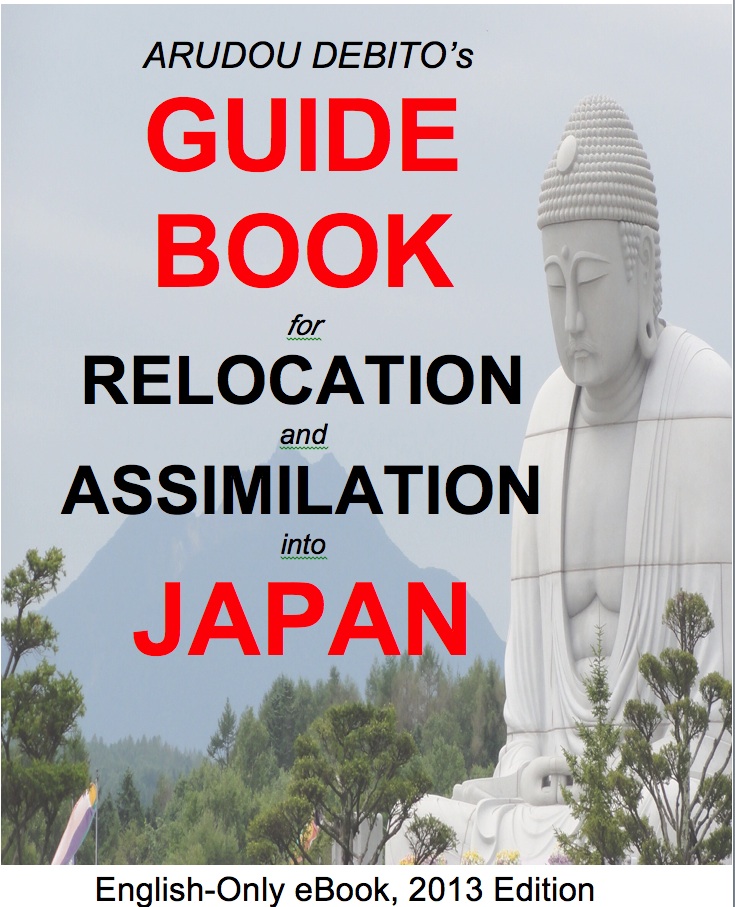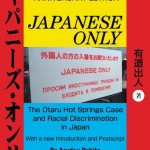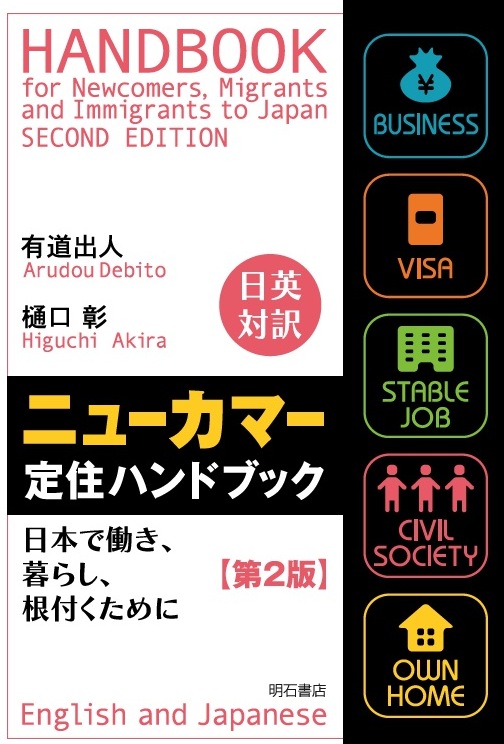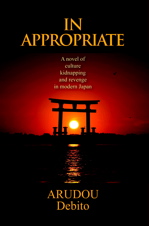mytest
eBooks, Books, and more from Dr. ARUDOU, Debito (click on icon):





![]()


UPDATES ON TWITTER: arudoudebito
DEBITO.ORG PODCASTS on iTunes, subscribe free
“LIKE” US on Facebook at http://www.facebook.com/debitoorg
http://www.facebook.com/handbookimmigrants
https://www.facebook.com/JapaneseOnlyTheBook
https://www.facebook.com/BookInAppropriate
If you like what you read and discuss on Debito.org, please consider helping us stop hackers and defray maintenance costs with a little donation via my webhoster:

All donations go towards website costs only. Thanks for your support!
Hi Blog. Now up with critique from an unexpected quarter is an extended interview I did with Dr. M.G. “Bucky” Sheftall on the WWII Japan Tokkō “Kamikaze” suicide missions, which appeared in an abridged version in the Japan Times as my JBC column on May 4, 2015. This longer version features more questions from me and more candor from Bucky. Here’s an excerpt:
Japan’s Kamikaze Suicide Pilots Exhibit at the USS Missouri in Honolulu: an interview with M.G. Sheftall
The Asia-Pacific Journal, Vol. 13, Issue. 22, No. 1, June 08, 2015
Dr. ARUDOU Debito, Dr. M.G. Sheftall
M.G. Sheftall, Professor of Modern Japanese History at Shizuoka University and author of Blossoms in the Wind: Human Legacies of the Kamikaze (Penguin 2005), was in Honolulu, Hawaii, aboard the battleship USS Missouri (site of the Japanese surrender in World War II) speaking at the dedication of a temporary exhibition of the Tokkō Kamikaze suicide pilots on April 10 and 11, 2015.
[…]
4) You mentioned earlier about other Tokkō missions, including the suicide motorboats. But we hear mostly about the pilots, hardly ever about the other types of Tokkō. Tell us a little more about these other branches, and why you think the pilots have garnered all the attention, especially in popular culture and at Yasukuni Shrine, where they are more famously enshrined as heroes?
Sheftall: In addition to the iconic self-immolating bomb-laden fighter plane version of Tokkō almost anyone inside or outside of Japan associates with the term “Kamikaze”, there were three other major Tokkō platforms that we could deem significant in terms of: 1) the expenditure involved in their development and production; 2) the initial expectations the Japanese military had for their success; and 3) the loss in human lives caused by their deployment. These were the Kaiten (“Fortune-reverser”) manned torpedo, the Shin’yō (“Ocean-shaker”) rammer-motorboat, and the Ōka (“Cherry Blossom”) manned rocket bomb – which was essentially a 1940s cruise missile with a human being in place of a computerized guidance and target acquisition system. Really brutal contraption.
In any case, all three of these platforms were bitter disappointments for the Japanese military. Each of them resulted in over a thousand “friendly” fatalities involved in attempts to deploy them – this is also counting the crew members of the “motherships” ferrying the Kaiten and Ōka (specially modified fleet submarines for the former, and specially modified twin-engined bombers for the latter) into battle – while only causing a few hundred Allied casualties in total between the three of them, as compared with “conventional” aviation Tokkō, which caused some 15 thousand Allied casualties just in the Battle of Okinawa alone. So, right off the bat I would say that this dismal operational history is certainly a sizable factor behind the rather low profile – and the poor reputation, when known at all – of these specialized Tokkō weapons in the postwar Japanese public imagination.
In other words, there’s not much “story-worthiness” there from the standpoint of either the producers or consumers of entertainment media content – which is of course how and where most postwar Japanese learn about Tokkō to begin with, not to mention most of their 20th century Japanese history. Also – and I hope this doesn’t sound as cynical as I’m afraid it might – these three Tokkō platforms would not have lent themselves to economically viable cinematic depiction in the pre-computer graphics era 1950s, 60s and 70s Japanese film industry – when the postwar Tokkō legacy took the decisive “semi-romanticized” turn in Japanese historical consciousness that has characterized it ever since, and that was itself largely the result of the influence of Tokkō films of the era, which were financed by sympathetic conservatives in the entertainment industry and “technically advised” by former IJA and IJN figures. A couple of Kaiten-themed films were made – one that comes to mind starred a young Ishihara Yūjirō during his breakout period – but the model-making and special effects were extremely challenging and also apparently quite expensive. Much more economical to use model airplanes against a rolling “sky” backdrop with some clouds painted on it, right? Plus the more claustrophobic, horrific, and yes, futile aspects involved with the specialized Tokkō platforms could be avoided. Instead, in the stock Tokkō story arc of the era, you have these dashing young men sitting around a single barracks room set, delivering soliloquys and speeches about the meaning of it all, then donning white pilot scarves and boarding their planes at the end of the movie to fly off into the clouds – literally disappearing into the heavens — as the credits roll and the stirring music kicks in. No blood-and-guts horror, no killing, no futility depicted. Fukuma Yoshiaki wrote a great media studies treatment some years back now on the postwar cinematic treatment of Tokkō. I would love to translate that someday.
Read it all at http://japanfocus.org/-M_G_-Sheftall/4326/article.html
ENDS
5 comments on “Asia-Pacific Journal: Japan Focus extended interview with Dr. M.G. Sheftall: “Japan’s Kamikaze Suicide Pilots Exhibit at the USS Missouri in Honolulu””
That’s a great article Dr. Debito, and I’m glad to be able to read the whole unabridged version.
I agree with Dr. Sheftall that if we consider the kamikaze pilots as ‘brainwashed’ then we should consider them no more brainwashed than the rest of Japanese society at that time. I consider them all to have been brainwashed- to such an extent that some of them still refuse to respond to all the positive stimuli that Japan’s post-war success shows them.
It’s also interesting to read Dr. Sheftall’s attack on Abe’s romanticization of the kamikaze (amongst others). It is interesting that a PM who views the war (from which he was absent) with such rose-colored glasses, is the same man who
1. This week removed civilian authority from the SDF;
http://www.japantimes.co.jp/news/2015/06/10/national/politics-diplomacy/defense-ministry-bureaucrats-lose-rank-superiority-sdf-officers/
2. This week is ignoring advice that his moves to makes Japan’s military is illegal under the constitution;
http://www.japantimes.co.jp/news/2015/06/10/national/politics-diplomacy/security-legislation-expanding-sdf-scope-constitutional-government-tells-foes-among-legal-experts/
Also, I read today that due to Abe’s reluctance to fire his ‘3rd arrow’, ministry mismanagement means Japan has another butter shortage;
http://www.japantoday.com/category/kuchikomi/view/bureaucratic-bungling-behind-butter-shortage
It seems that in the 21st century, in a first world nation, and the world’s #3 economy, the Prime Minister is giving the Japanese people a choice;
‘Do you want guns or butter?’
Now that I got what you mean by “something I had expected in the past happened.” I think Dr. Sheftall’s research project is way better than most history projects funded by Smithsonian Museum or billion dollar corporations like Gates Foundation or the Eli Broad.
The interview in Japan Focus is well worth reading. I did not know, for example, that the so called Kamikaze pilots were only part of the last ditch efforts being made by the military in 1944-45 to stave off defeat.
The work done by Prof. Sheftall on this is so important. It’s not about political posturing or pandering to prejudice. Humanity. I think Prof. Sheftall has found a way to navigate an area and a space beyond bully pulpit posturing by crazed neoshintonazis or nukedthecrazedjaps racists.
I’m just gonna’ go ahead and paste the quote by Yuki Tanaka, without any further comment from me on this thread:
“Very few of these letters and diaries actually express a clear anti-war sentiment. Simply reading these documents and viewing the photos of these youths does not naturally or inevitably give rise to strong anti-war sentiment.”
“In order to raise anti-war sentiment among observers, it would be vital to provide accurate historical background information on how and why Japan waged war throughout the Asia Pacific region over 15 years, and how such an inhumane tactic as suicide attacks was adopted, wasting the lives of thousands of youths, and indeed, extended in the final year of the war to many other draftees and civilians ordered to commit suicide rather than surrender. Yet the exhibition at Chiran Tokko Heiwa Kaikan offers no such basic information. On its homepage in Japanese (http://www.chiran-tokkou.jp/index.html), for example, it provides just a short history of the war, starting from the Pearl Harbor attack by Japanese naval forces on December 7, 1941. It thereby ignores Japan’s war of aggression in China, which began in September 1931 in Manchuria and extended throughout China from 1937. It also makes no mention of the various atrocities that the Japanese Imperial Army committed throughout the Asia Pacific region during the following 15 years. Furthermore, CTHK attributes the main cause of the Pacific War to the economic blockade, in particular the oil embargo that the US introduced against Japan. CTHK claims that Japan was pushed into the war against the Western imperial nations, which colonized many parts of Asia, thereby giving the impression that Japan had no other option but to wage war against the Allied forces. (The home page in English omits all reference to this historical background.)”
“The message provided by the Kaiten Memorial Museum (hereafter KMM) at Ohtsu, a former naval base for the suicide midget submarine attack force in Yamaguchi Prefecture, is basically the same as that of CTHK. Its homepage (http://www.city.shunan.lg.jp/section/ed-sports/ed-shogai-bunka/kaiten/) begins with the words “The (Kaiten) members departed on their mission of attack intending to sacrifice their own lives in order to protect their homeland and loved ones.” The homepage provides no explanation whatsoever about the cause of the war. Its official pamphlet gives the impression that many young boys voluntarily joined this force, claiming simply that “many young boys came to this base from all over Japan…. determined to protect their mother land.” As in CTHK, KMM is filled with exhibits of photos of young boys together with their final letters and diaries written by Kaiten members, their contents strikingly similar to those written by Kamikaze pilots. The total number of boys trained as Kaiten attack members was 1,375, of whom 87 died in actual suicide missions.”
“When I visited CTHK several years ago, I joined a guided tour. The guide’s brief explanation of the war history was identical to that detailed on CTHK’s home page. Explaining the contents of letters and diaries, he praised the courage shown by those young boys and the deep love they expressed for their kin, girlfriends and particularly for their mothers and homeland. In conclusion, he claimed that it is thanks to the sacrifice of these boys that Japan was able to rebuild as a nation so quickly and to become a prosperous nation. This kind of explanation is characteristic of claims by conservative politicians to justify the millions of Japanese and tens of millions of Asian lives lost in war. At the end of the tour I asked about something the guide had not touched on during the tour. I inquired about 11 Korean Kamikaze pilots who flew out from Chiran for their last mission. Why did those Koreans become Kamikaze pilots? Did they really volunteer to become pilots? How did they feel about dying for Japan, which had colonized their homeland? The guide, who was probably in his late 60s or early 70s, had no answer to my questions.”
“It is natural that most Kamikaze pilots wrote about their personal feelings and expressed love for kin and girlfriends in their letters and diaries, knowing that they had little time left to live. The social and political constraints at the time, however, meant that they could not clearly express their feelings about the war, especially Japan’s relationship with China and other Asian nations as well as the Allied countries. Nor could they discuss the war strategy that military leaders were undertaking at the time. Pilots protected themselves and their relatives with ‘self-censorship:’ they knew that their letters would be checked, and in fact their diaries and other writings were scrutinized before being returned to relatives after the pilots’ deaths. In other words, with few exceptions, their writings were apolitical, containing little reference to political or ideological assessments of the war and its leaders. The nature of these manuscripts, thus, easily leads to romanticization of their feelings. The typical format is that of a young boy being forced to die on a suicidal mission, knowing full well that Japan was on the verge of defeat, yet overcoming his fear of death by rationalizing his act of self-annihilation as an expression of love for his mother or girlfriend. It was the projection of this romanticized image that led these men to be seen as war heroes while leaving intact official narratives concerning the war. For this reason, feature films with themes of kamikaze pilots or other types of suicidal attacks are extremely popular in Japan and almost every year a few such films are produced and screened throughout the country. In short, the presentation of the stories of these young Kamikaze pilots in this way can be politically exploited to enhance war-inspired patriotism and male chauvinism among young children, who visit the museum and see films on this topic. Not surprisingly, leading nationalist politicians such as Koizumi Junichiro and Abe Shinzo, who visited CTHK in their capacity as prime minister, praised the way that the museum presents ‘war heroes.’ In short, emphasizing the ‘humanity’ of kamikaze pilots does not automatically lead to nurturing anti-war sentiment or peace consciousness. Humanity can be exploited to enhance national sentiment and patriotism when romanticized and idealized. The volatile duality of the ‘humanity’ of Kamikaze pilots is something that can be learned from this exhibition.”
“Undoubtedly war is an act of madness, its absurdity clearly shown in the paired (but imbalanced) actions and reactions of World War II: as Japan adopted kamikaze-style suicide attacks, the US used ‘strategic bombing’ to indiscriminately kill hundreds of thousands of civilians as in the fire bombing of more than one hundred Japanese cities and towns, and finally engaged in atomic bombing attacks. Yet, to a great extent, it is the former acts that have borne the opprobrium of history while the latter would not only be cloaked in the aura of victory, but would come to shape the strategic horizons of subsequent wars. Thus terrorist suicide bombing, which is occurring more and more frequently throughout the world, bears the opprobrium of ‘lunatic actions by fanatics,’ while the bombing of civilians, such as those executed by U.S. and British forces in Afghanistan and Iraq, are widely regarded as ‘legitimate military operations.’ It is crucial that we find effective ways to break the vicious cycle of these two types of terrorism.”
Unfortunately, however, even 70 years after the war both Japan and the U.S. are still trying not only to justify, but even to glorify, their inhumane wartime conduct. Despite the failure last year to achieve registration on UNESCO’s Memory of the World list, CTHK is making great efforts this year to have their collection registered. UNESCO rejected CTHK’s application last year on the grounds that the explanation of the collection is based simply on a ‘Japanese interpretation’ and lacks a ‘universal message.’ For its part, the U.S. last year introduced a new law to create the Manhattan Project National Historical Park in order to preserve the facilities of three major sites, Oak Ridge, Hanford, and Los Alamos. It was at these places that the production of atomic bombs that killed tens of thousands of people took place. (Interestingly, China is now requesting that UNESCO register the documents related to the Nanjing Massacre and comfort women as Memories of the World.)”